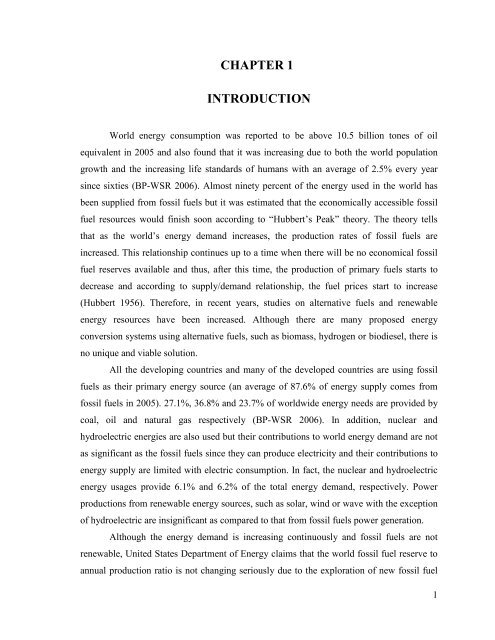hydrogen production from water using solar cells powered nafion ...
hydrogen production from water using solar cells powered nafion ...
hydrogen production from water using solar cells powered nafion ...
You also want an ePaper? Increase the reach of your titles
YUMPU automatically turns print PDFs into web optimized ePapers that Google loves.
CHAPTER 1<br />
INTRODUCTION<br />
World energy consumption was reported to be above 10.5 billion tones of oil<br />
equivalent in 2005 and also found that it was increasing due to both the world population<br />
growth and the increasing life standards of humans with an average of 2.5% every year<br />
since sixties (BP-WSR 2006). Almost ninety percent of the energy used in the world has<br />
been supplied <strong>from</strong> fossil fuels but it was estimated that the economically accessible fossil<br />
fuel resources would finish soon according to “Hubbert’s Peak” theory. The theory tells<br />
that as the world’s energy demand increases, the <strong>production</strong> rates of fossil fuels are<br />
increased. This relationship continues up to a time when there will be no economical fossil<br />
fuel reserves available and thus, after this time, the <strong>production</strong> of primary fuels starts to<br />
decrease and according to supply/demand relationship, the fuel prices start to increase<br />
(Hubbert 1956). Therefore, in recent years, studies on alternative fuels and renewable<br />
energy resources have been increased. Although there are many proposed energy<br />
conversion systems <strong>using</strong> alternative fuels, such as biomass, <strong>hydrogen</strong> or biodiesel, there is<br />
no unique and viable solution.<br />
All the developing countries and many of the developed countries are <strong>using</strong> fossil<br />
fuels as their primary energy source (an average of 87.6% of energy supply comes <strong>from</strong><br />
fossil fuels in 2005). 27.1%, 36.8% and 23.7% of worldwide energy needs are provided by<br />
coal, oil and natural gas respectively (BP-WSR 2006). In addition, nuclear and<br />
hydroelectric energies are also used but their contributions to world energy demand are not<br />
as significant as the fossil fuels since they can produce electricity and their contributions to<br />
energy supply are limited with electric consumption. In fact, the nuclear and hydroelectric<br />
energy usages provide 6.1% and 6.2% of the total energy demand, respectively. Power<br />
<strong>production</strong>s <strong>from</strong> renewable energy sources, such as <strong>solar</strong>, wind or wave with the exception<br />
of hydroelectric are insignificant as compared to that <strong>from</strong> fossil fuels power generation.<br />
Although the energy demand is increasing continuously and fossil fuels are not<br />
renewable, United States Department of Energy claims that the world fossil fuel reserve to<br />
annual <strong>production</strong> ratio is not changing seriously due to the exploration of new fossil fuel<br />
1

















